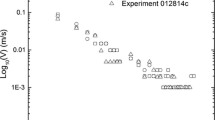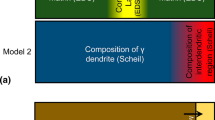Abstract
Diffusion is an important phenomenon involved in thermal processing, e.g., a Si diffusion in an (Al–Si)-KxAlyFz clad alloy during aluminum (Al–Mn) brazing, to be considered in this study. Specifically, the Si migration affects the amount of liquid metal available to form a mating surfaces’ bond and further influences the solid substrate dissolution at the liquid–solid interface between (Al–Si)-KxAlyFz and Al–Mn. These events greatly impact the performance (e.g., joint formation) of the materials involved. To quantify theoretically the available liquid metal contributing to the subsequent joint formation, the diffusion process is in the first approximation divided into two evolving time segments, both before the onset of resolidification: 1. the solid-state Si diffusion prior the clad melting and 2. the liquid state Si diffusion after the clad melting. Of the two segments, the later has not been addressed in the available literature. The analysis of the sequence of the solid and liquid diffusion segments has been facilitated by performing a series of experimental benchmark studies. The Si solid diffusion across the clad–core interface has been monitored at 150 °C, 250 °C, 350 °C, 450 °C and 550 °C peak temperatures. Each dwell at the peak lasted for 10 min. For the study of the impact of liquid diffusion on the solid substrate, the experiments have been performed at the peak temperature of 600 °C with different heating rates, ranging from 1 to 60 °C/min. The joint formation process evolution has been modeled, and an excellent agreement with empirical data has been established.
Graphical abstract











Similar content being viewed by others
References
Sekulic DP (2018) Brazing of Aluminum Alloys. In: Anderson K, Weritz J, Kaufman JG (eds) ASM Handbook. ASM International, Novelty, pp 763–782
Sekulic DP (2013) Advances in brazing: science, technology and applications. Woodhead publishing, Cambridge
American Welding Society (AWS) C3 Committee on brazing and soldering (2007) Brazing Handbook, 5th ed. American Welding Society, Miami
Hawksworth DK (2013) Fluxless brazing of aluminum. In: Sekulic DP (ed) Advances in brazing. Woodhead publishing, Cambridge, pp 566–584
Fujikawa S, Hirano K, Fukushima Y (1978) Diffusion of silicon in aluminum. Metall Trans A 9:1811–1815
Kirkendall EO (1942) Diffusion of zinc in alpha brass. Trans Am Inst Min Metall Eng 147:104–110.
Terrill JR (1966) Diffusion of silicon in aluminum brazing sheet. Weld J 45:S202-209
Mantina M, Wang Y, Chen LQ et al (2009) First principles impurity diffusion coefficients. Acta Mater 57:4102–4108. https://doi.org/10.1016/j.actamat.2009.05.006
McCaldin JO, Sankur H (1971) Diffusivity and solubility of Si in the Al Metallization of Integrated Circuits. Appl Phys Lett 19:524–527. https://doi.org/10.1063/1.1653799
Van Gurp GJ (1973) Diffusion-limited Si precipitation in evaporated Al/Si films. J Appl Phys 44:2040–2050. https://doi.org/10.1063/1.1662511
Garg N, Castleman LS, D’Antonio C (1984) Diffusion of silicon in aluminum-rich alloy thin films. Thin Solid Films 112:317–328
Paccagnella A, Ottaviani G, Fabbri P et al (1985) Silicon diffusion in aluminium. Thin Solid Films 128:217–223. https://doi.org/10.1016/0040-6090(85)90073-2
Freche HR (1936) Diffusion of Magnesium and Silicon into Aluminum. Trans AIME 122:324
Beerwald A (1939) Diffusion of various metals in aluminum. Z Elektrochem Angew Phys Chem 45:789–795
Mehl RF, Rhines FN, Von Den Steinen KA (1941) Diffusion in alpha solid solutions of aluminium. Met Alloy 13:41–44
Buckle H (1943) The diffusion of Cu, Mg, Mn and Si into Al. Z Elektrochem Angew Phys Chem 49:238–242
Roth W (1960) Ueber die Diffusion von Metallen in Aluminium. Met und Tech 14:979–983
Fricke WG Jr (1965) Graphical computation of diffusion from saturated solid solutions. ASM Trans 58:421–424
Fricke WG Jr (1972) Correlation between frequency factor and activation energy for diffusion in aluminum. Scr Metall 6:1139–1144
Bergner D, Cyrener E (1973) Diffusion of foreign elements in aluminum solid solutions. Pt. 3. Investigations into the diffusion of silicon in aluminum using the microprobe. Neue Hutte 18:356–361
Hirano K, Fujikawa S (1978) Impurity diffusion in aluminum. J Nucl Mater 69–70:564–566. https://doi.org/10.1016/0022-3115(78)90275-1
Gao F, Zhao H, Sekulic DP et al (2002) Solid state Si diffusion and joint formation involving aluminum brazing sheet. Mater Sci Eng A 337:228–235. https://doi.org/10.1016/S0921-5093(02)00031-X
Senaneuch J, Nylén M (2002) Diffusion modelling in brazed aluminium alloy components. In: Materials Science Forum. Trans Tech Publ, pp 1697–1702
Du Y, Chang YA, Huang B et al (2003) Diffusion coefficients of some solutes in fcc and liquid Al: critical evaluation and correlation. Mater Sci Eng A 363:140–151. https://doi.org/10.1016/S0921-5093(03)00624-5
Gale WF, Totemeir TC (2004) Smithells Metals Reference Book, 8th edn. Butterworth-Heinemann, Oxford
Pearce JV (2016) Survey of key parameters of impurities in aluminum: Diffusion coefficients, solubility and liquidus slopes. Int J Thermophys. https://doi.org/10.1007/s10765-016-2128-z
Wernick JH (1956) Determination of diffusivities in liquid metals by means of temperature-gradient zone melting. J Chem Phys 25:47–49. https://doi.org/10.1063/1.1742846
Lozovskiy VN, Politova NF, Shutova YV (1968) Temperature dependence of the diffusion coefficient of silicon in molten aluminum. Phys Met Metallogr 26:189–190
Ershov GS, Kasatkin AA, Golubev AA (1979) Dissolution and diffusion of alloying elements in liquid aluminum. Izveestiya Akad Nauk SSSR, Met 2:77–79
Poirier DR (2014) Density, viscosity and diffusion coefficients in hypoeutectic Al–Si liquid alloys: an assessment of available data. Metall Mater Trans B Process Metall Mater Process Sci 45:1345–1354. https://doi.org/10.1007/s11663-014-0037-8
Seyed Ahmadi M, Argyropoulos SA, Bussmann M, Doutre D (2015) Comparative studies of silicon dissolution in molten aluminum under different flow conditions, part i: single-phase flow. Metall Mater Trans B Process Metall Mater Process Sci 46:1275–1289. https://doi.org/10.1007/s11663-015-0299-9
Huang X, Dong X, Liu L, Li P (2019) Liquid structure of Al–Si alloy: a molecular dynamics simulation. J Non Cryst Solids 503–504:182–185. https://doi.org/10.1016/j.jnoncrysol.2018.09.047
Uemura K (1939) The diffusion of various elements into aluminium in molten state (I). Tetsu-to-Hagane 25:24–29. https://doi.org/10.2355/tetsutohagane1915.25.1_24
Craighead CM, Cawthorne EW, Jaffee RI (1955) Solution rate of solid aluminum in molten Al–Si alloy. JOM 7:81–87
Kosaka M, Machida M, Hirai Y (1969) On the dissolution process of solid aluminum in molten aluminium–silicon alloy. J Japan Inst Met 33:465–470
Nakagawa H, Lee CH, North TH (1991) Modeling of base metal dissolution behavior during transient liquid-phase brazing. Metall Trans A 22A:543–555. https://doi.org/10.1007/BF02656822
Turriff DM, Corbin SF, Kozdras M (2010) Diffusional solidification phenomena in clad aluminum automotive braze sheet. Acta Mater 58:1332–1341. https://doi.org/10.1016/j.actamat.2009.10.037
Kawase H, Takemoto T, Asano M et al (1989) Study of a method for evaluating the brazeability of aluminum sheet. Weld J 68:396s–403s
Sekulic DP, Gao F, Zhao H et al (2004) Prediction of the fillet mass and topology of aluminum brazed joints. Weld J 83:102s–110s.
Sekulic DP, Zellmer BP, Nigro N (2001) Influence of joint topology on the formation of brazed joints. Model Simul Mater Sci Eng 9:357–369. https://doi.org/10.1088/0965-0393/9/5/302
Sekulic DP (2001) Molten aluminum equilibrium membrane formed during controlled atmosphere brazing. Int J Eng Sci 39:229–241. https://doi.org/10.1016/s0020-7225(00)00022-7
Zhao H, Sekulic DP (2006) Diffusion-controlled melting and re-solidification of metal micro layers on a reactive substrate. Heat Mass Transf 42:464–469. https://doi.org/10.1007/s00231-005-0643-8
Zellmer BP, Nigro N, Sekulic DP (2001) Numerical modelling and experimental verification of the formation of 2D and 3D brazed joints. Model Simul Mater Sci Eng 9:339–355
Ogilvy AJW, Hawksworth DK, Abom E (2014) U.S. Patent No. 8871356. 2–7
Hawksworth DK, Westergård RGJ, Ogilvy AJW (2012) Trillium technology-Aluminium brazing with a composite liner. In: 7th International Congress Aluminium Brazing. DVS, pp 1–5
Hawksworth DK, Sekulic DP, Yu C-N et al (2015) A mechanistic study of aluminium controlled atmosphere brazing processes. 12th Vehicle Thermal Management Systems Conference and Exhibition, May. Nottingham, U.K, pp 10–13
Lacaze J, Tierce S, Lafont MC et al (2005) Study of the microstructure resulting from brazed aluminium materials used in heat exchangers. Mater Sci Eng A 413–414:317–321. https://doi.org/10.1016/j.msea.2005.08.187
Wu Y, Fu H, Hawksworth DK, et al (2018) Diffusion fields in TRILLIUMTM brazing sheet under different heating rates. In: Proceedings of 7th International brazing and soldering conference (IBSC). AWS, New Orleans, LA, pp 41–49
Lübbehusen M, Mehrer H (1990) Self-diffusion in α-iron: The influence of dislocations and the effect of the magnetic phase transition. Acta Metall Mater 38:283–292. https://doi.org/10.1016/0956-7151(90)90058-o
Lundy TS, Padgett RA (1968) The near-surface effect for diffusion in silver. Trans Met Soc AIME 242:1897–1900
Matano C (1933) On the relation between the diffusion-coefficients and concentrations of solid metals. Japanese J Phys 8:109–113
Bishop M, Fletcher KE (1972) Diffusion in aluminium Int Metall Rev 17:203–225
Crank J (1975) The Mathematics of Diffusion, 2nd edn. Oxford University Press, Oxford
Murray JL, McAlister AJ (1984) The Al–Si (Aluminum–Silicon) system. Bull Alloy Phase Diagrams 5:74–84. https://doi.org/10.1007/BF02868729
Wu Y (2020) Capillary flow of liquid aluminum alloy in wetting and wetting/non-wetting systems. PhD dissertation, University of Kentucky
Yu C-N, Hawksworth DK, Liu W, Sekulic DP (2012) Al brazing under severe alterations of the background atmosphere: A new vs. traditional brazing sheet. In: Proceedings of the 5th International Brazing and Soldering Conference (IBSC). pp 347–354
Miller MA (1946) Metal flow and fillet formation in brazing aluminum. Weld J 25:102s–114s
Mehrer H (2007) Diffusion in solids: fundamentals methods materials. Springer, Berlin
Acknowledgements
This work has been funded in part within NASA’s Physical Sciences Research Program, Grant# NNX17AB52G. TRILLIUM® materials were provided by Gränges AB, Finspång, Sweden. TRILLIUM® technology is protected by United States Patent No. 8871356 as well as by corresponding patents and pending patent applications in other major countries. TRILLIUM® is a registered trademark of Gränges AB, Sweden. The authors also appreciate the discussion on the subject with Dr. Doug K. Hawksworth (Diomedea Inc. Canada) during his visit to University of Kentucky and the valuable suggestions provided by Mr. Slawomir Koscielski (Gränges AB, Sweden).
Author information
Authors and Affiliations
Corresponding author
Ethics declarations
Conflict of interest
The authors declare that they have no conflict of interest.
Additional information
Handling Editor: N. Ravishankar.
Publisher's Note
Springer Nature remains neutral with regard to jurisdictional claims in published maps and institutional affiliations.
Appendices
Appendix A
Mean liquid diffusion coefficient
The mean liquid diffusion coefficient \(\overline{{D_{liquid} }} = { 3}.{63 } \times { 1}0^{{ - {11}}}\) m2/s is calculated based on the following conditions: (1) the liquid diffusion range’s starting temperature is 590 °C; (2) the silicon solid solubility in aluminum, \({c}_{s}\), used in Eq. (4) is 1.1 wt%, which is evaluated at 600 °C. Alternative conditions may also be taken into consideration. For example, the liquid diffusion may already take place at the solidus line at 577 °C, which will affect both the solid and liquid diffusion time and as a result, influence the value of the liquid diffusion coefficient; In addition, the silicon solid solubility in aluminum, \({c}_{s}\), is changing with temperature. Thus, the boundary condition involved in Eq. (4) may also change. The current GDOES or EDS measurement is not sensitive enough to tell the difference. This also affects the calculation of the liquid diffusion coefficient. Table 5 illustrates the average liquid diffusion coefficient of Si at around 600 °C. The values vary from 1.00 × 10–11 to 3.63 × 10–11 m2/s, depending on different liquid diffusion starting temperature and silicon solubilities. These numbers are an order of magnitude larger than that of the pure solid diffusion coefficient of Si, which is 1.47 × 10–12 m2/s as indicated in Table 3.
Rights and permissions
About this article
Cite this article
Wu, Y., Yu, CN. & Sekulic, D.P. Si diffusion across the liquid/solid interface of capillary driven (Al–Si)-KxAlyFz micro-layers. J Mater Sci 56, 7681–7697 (2021). https://doi.org/10.1007/s10853-020-05689-x
Received:
Accepted:
Published:
Issue Date:
DOI: https://doi.org/10.1007/s10853-020-05689-x




